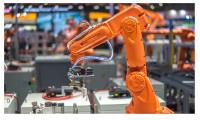 Add My Company
Add My Company
Sign In
The Future of Robot Arms in Construction
17-11-2022

Innovation is not just the prerogative of science-fiction writers. Industries are constantly renovating and pushing the boundaries of what they know and can do. Something we are continually seeing within the robotics industry. We have seen how rapidly robots and robot arms have found a place within many industries. Their use has safely speeded up production lines, taking over monotonous, repetitive work and creating new jobs and skills within the workforce. However, the pace has been much slower in the Construction Industry, but fear not, it is happening.
Robots In Construction
A lot of construction tasks for robots are still in the research field. There are places where robots and especially robotic arms are being introduced. This introduction is already showing signs of their usefulness, and the improvements we can expect in construction areas include,
Increased accuracy
Meeting deadlines
Significantly increased productivity
Reducing errors
Reducing the number of accidents
Reducing costs
We can expect to see the ability of robots appear in areas like:
Prediction of required tasks.
Evaluation of the progress of a project.
Early detection of possible errors.
Automation of dangerous tasks for the operators.
Surveillance and inspection tasks.
What Are The Predictions For The Robot Arms of the Future?
Construction robotics and automation will become commonplace in the construction industry, bringing their own particular skill sets in safety, efficiency and precision. We will see robots programmed and optimised to carry out specific tasks, accelerating the process and maintaining consistency and accuracy. For example, using robot arms remotely could reduce the well-known dangers of working on scaffolds.
There are many tasks within the construction industry that robotic arms are well suited for without taking the place of skilled workers. However, workers are in short supply, and with demands for construction falling short, there are jobs they can do now.
Like bricklaying by a robotic arm on a track. Or using a pick and place, a robotic arm attached to a mobile platform. Robotic arms for 3D printing have been around for a while. Still, the combination of a robot arm on a track or mobile platform could, in effect, build the walls of a building from a 3D CAD model. Ensuring precision and speed in construction and creating a positive solution to the housing crisis.
Hurdles To Robots In Construction
There are several hurdles to using robots in construction. One is to create a functioning robot at a cost that can be met is essential. Then there is also the ingrained mistrust people have over innovations and robots in particular.
Despite rigorous safety testing, placing robots in high-risk environments like high-rise buildings is of concern to many. In addition, builders, architects and their clients may be concerned about the long-term stability of a structure made by robots. Another issue is one of access for a robot. They require space to function, so while easy enough to lay tracks on a new build, it might be a lot more of a problem on a renovation. All these concerns need recognising, respect and addressing before we can move on to introducing robots into the construction workplace.
Times They Are A Changing
Behind the scenes in the construction industry, robots have found a place. They are busily building 3D structures. In addition, robotic drones are helping with surveillance and site security and speeding up the process of testing for environmental impact or problems in construction areas.
Robots and robotic arms are an essential part of the way forward, from building bridges to maintaining our roads and constructing our homes and workplaces. Robotics is a way to assist and help, and they are very good at it. So let us be on board for what the future will bring.
For more information on The Future of Robot Arms in Construction talk to Robot System Products
Enquire Now
List your company on FindTheNeedle.
